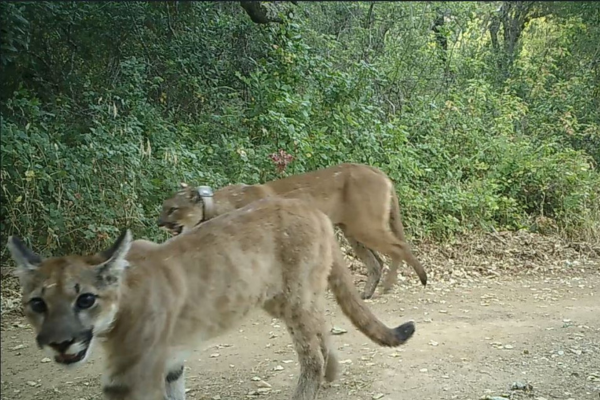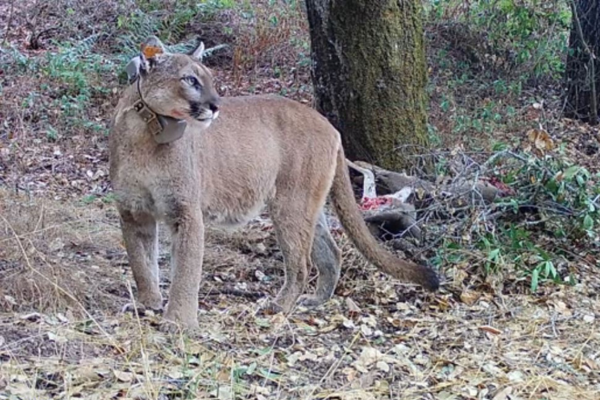Collared Mountain Lion With 3 Kittens Killed On Pacheco Pass
Collared female mountain lion F337 was hit and killed along Highway 152 in late November 2024. The status of her three kittens is still uncertain. Monitoring F337 and watching as her kittens grew was an extremely enjoyable part of my job, and her passing deeply saddened me.
F337 was captured, sampled, and GPS collared to support the planning of the Santa Clara Valley Habitat Agency’s Pacheco Pass Wildlife Crossing and continued mountain lion conservation efforts throughout California.
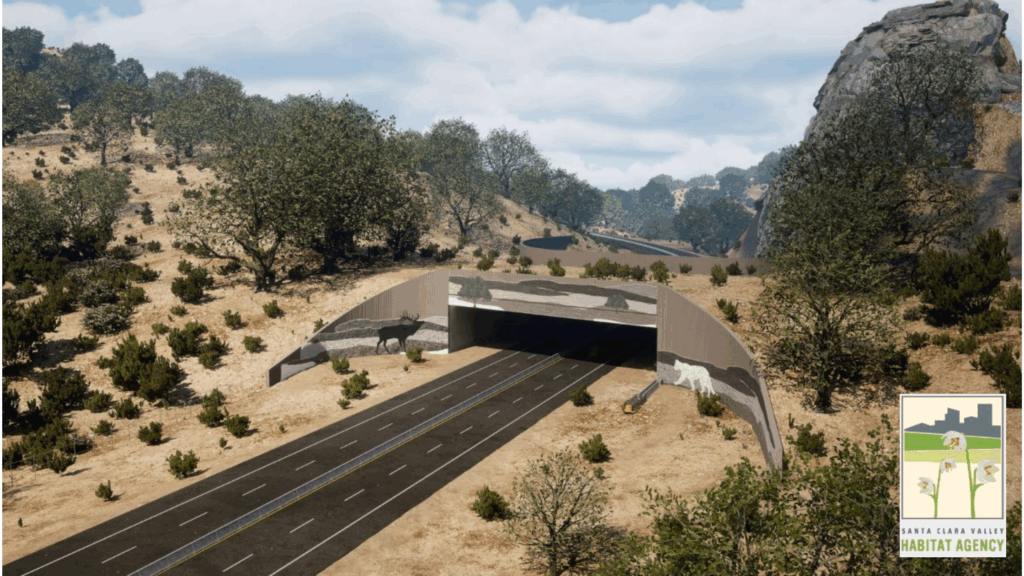
Mountain Lion F337 was Particularly Special to Me
Although I had previously assisted on multiple lion captures, F337 was my first capture as the lead biologist for the Pachecho and Gabilan Mountain Lion Projects. I was tasked with investigating new properties, deploying cameras and baits, and ultimately getting her into a trap.
My supervisor at the UC Davis Wildlife Health Center’s California Carnivores Program, Dr. Fernando Najera, led the immobilization and workup of F337. However, my involvement, which included the efforts leading up to her capture and observing her for a year, created a unique connection for me.
Capturing California Mountain Lion F337
Due to the challenges of maintaining mountain lion baits among a high density of feral pigs, I placed the road kill deer on top of a stump instead of on the ground as is typically done. At the time, we were uncertain how a lion might approach the novel scenario, whether or not they would initially feed on the bait, and, given the inability to cache it, whether they would return the following night.
Setting a Mountain Lion Bait
Although there are several ways to live-capture mountain lions, we most commonly utilize large single-door box traps. The first step in capturing lions is confirming their presence in the area. We do this by scouting for sign, including tracks, scat, and scrapes, and assessing the resources (cover and deer abundance). We then deploy trail cameras, and once consistent lion activity is detected, we set baits.
Note – We rely heavily on various individuals and organizations, including Tallow and Caltrans, that collect roadkill deer from local streets and highways to provide most of our mountain lion bait. We store our bait in multiple large chest freezers near our study sites and utilize MarCell Pro Freeze Alarms to monitor freezer temperatures and alert us if there is a power outage. If you need one of these units, coupon code WildlifeDetections25 will save you $25 on your order.
A mountain lion bait site typically consists of roadkill deer wired to a tree, two Tactacam cellular trail cameras, a predator call, and sometimes, a dangle (feather and bone) to catch the eye of a passing lion. We drag the deer into position from a nearby road or trail to create a scent path, and the predator call is set to emit repeated sounds of a distressed deer fawn or rabbit throughout the night.
In most cases, we can drag the deer carcass directly from a truck or ATV, but we also utilize game carts and frame packs to set baits in more remote locations.
Note: A relatively recent addition to our baiting efforts is the use of CamPark cellular security cameras, which enable us to manually access the video feed and communicate through the camera, allowing us to scare scavengers off the bait.
Mountain Lion F337 Takes the Bait

Within a day or two of setting the bait, we detected two mountain lions feeding on the tree-stump-anchored deer carcass. The adult female had fed alone earlier in the night and then brought her kitten with her for a mid-morning snack. The youngster (lower left) took an interesting approach to the bait, spending more time playing than eating.
Covering or caching the carcass is a telltale sign that a mountain lion intends to return for another feed, but not all lions do this consistently. In this instance, multiple feedings with plenty of bait remaining suggested they would return, so we prepared to set our traps later that evening.
A mountain lion will stay near a kill or cache, so it is necessary to be stealthy when setting the traps. At least two traps are set, even if only one individual is detected. On a few occasions, a mountain lion has been able to escape a trap before the door fully closed, or they have triggered the trap from the outside while attempting to access the bait. In this instance, we were hoping to capture both individuals.
Deer parts were attached to the back of each trap, and the traps were placed adjacent to one another and wired to a tree. Grass was laid on the trap floors to conceal the treadle, and sticks were stacked along the back half of each trap to encourage the lion to enter through the open door. In addition to the cell cameras positioned at each trap’s opening, sensors were also attached to the trap doors to alert us if the trap was triggered.
We parked nearby, within a five-minute drive, monitored the cameras, and prepared for a long night.
Mountain Lion F337 Captured
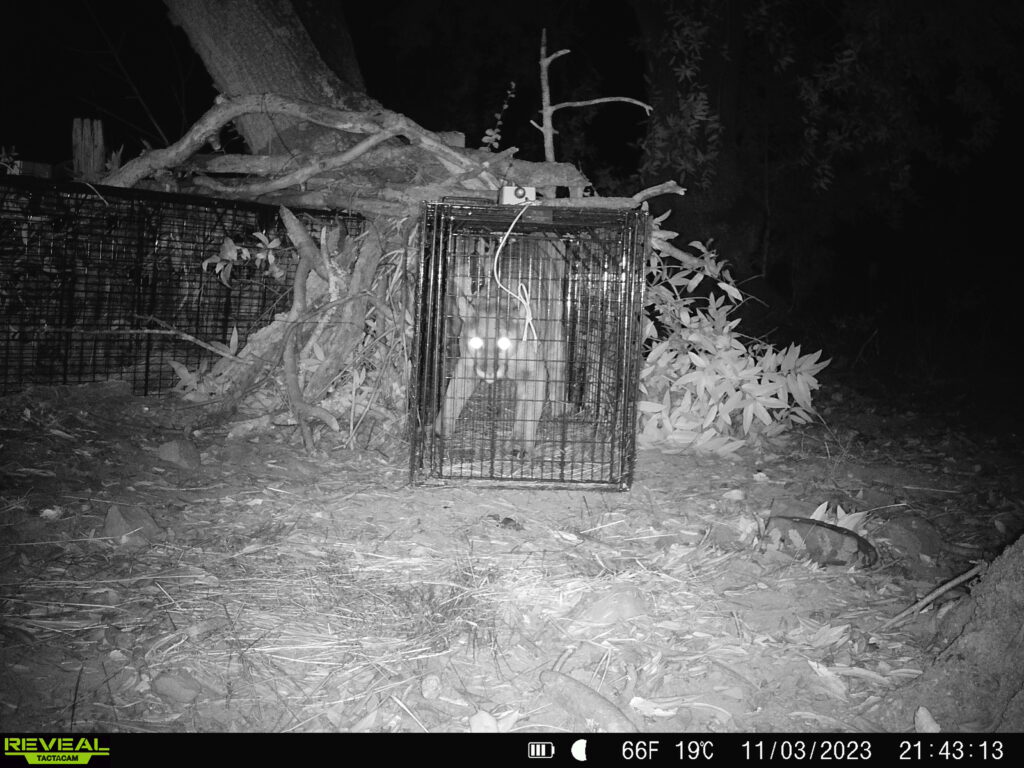
At 9:43 p.m., the adult female mountain lion entered the trap with minimal hesitation. Her kitten was not with her. We arrived within minutes, quickly estimated her weight, covered the trap with a blanket, and prepared our workup gear.
A Mountain Lion Workup and Health Check
A cocktail of Ketamine and Medetomidine was loaded into a syringe affixed to the end of a jab stick. While one person distracted the lion, Dr. Najera approached from the opposite side and stealthily injected the sedative into a meaty hip.
The blanket was placed back over the trap, and the crew remained silent while the lion fell asleep. Unlike in the movies, when a person or animal is darted with a tranquilizer and is immediately rendered unconscious, it takes around 6-9 minutes for the lion to drift off entirely. That is why darting an animal in risky situations is often not an option.
Once tractable, the lion was slid onto an animal carry stretcher, and her vitals were assessed. We then carried her over to the workup location and measured her weight. We lubricated her eyes, placed a hood over her face, and began providing oxygen.
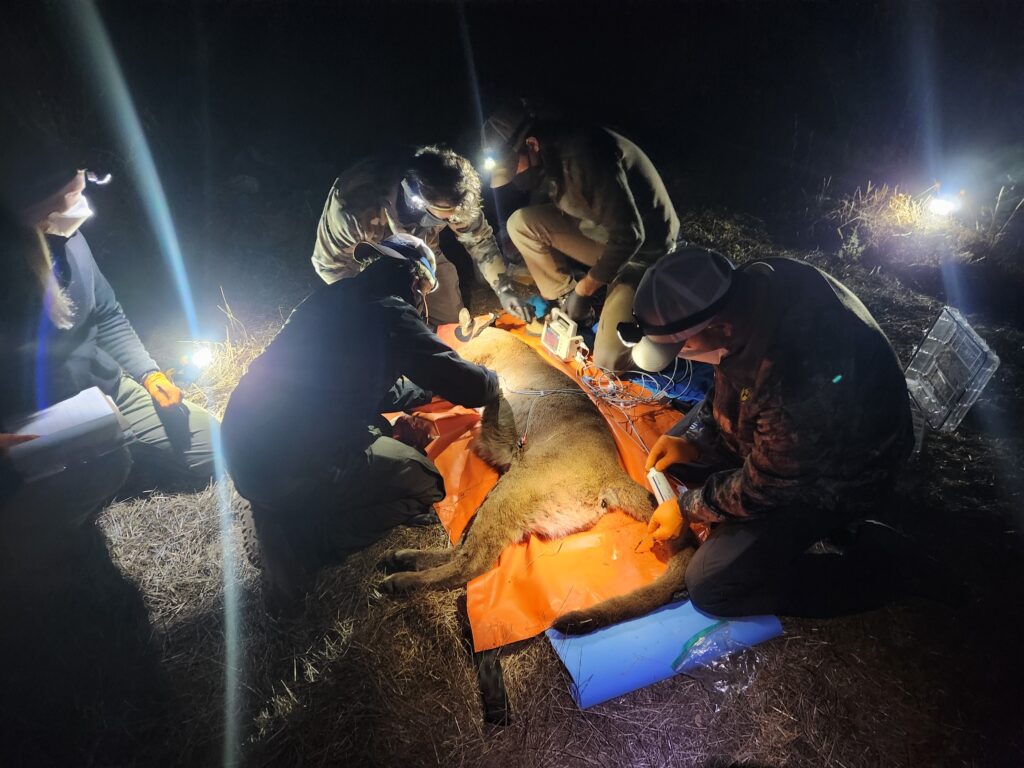
A CONTEC Veterinary Monitor was used to monitor the lion’s EKG (Heart Rate), RESP (Respiration), SpO2 (Oxygen Saturation), Temperature, and Pulse during the workup. Additionally, 500 ml of fluids (Lactated Ringers) were administered subcutaneously.
While Dr. Najera drew blood, I assisted in fitting the lion with a Vectronic GPS Collar, attaching an ear tag (#337) to the right ear, and applying a matching number tattoo to the inside of her left ear.
We then collected hair and whisker samples, swabs from the rectum, nose, and throat, measured gum recession to estimate her age, and recorded the lengths of the upper and lower canines. Additionally, we recorded numerous standard body measurements.
During the health assessment, Dr. Najera palpated the lion’s abdomen to assess the internal organs, feel for any abnormal masses, and check for pregnancy. He also examined the lion’s eyes, ears, and mouth, and assessed each hip, leg, and toe joint for injuries. The lion was rotated to ensure all angles were observed, and numerous photos were taken.
The lion, now referred to as F337, due to her numbered ear tag, was carried to a safe release location, and the reversal agent (Atipamazole) was injected into her right shoulder. The entire process, from the initial injection of the sedative to the administration of the reversal, took just under one hour.
Mountain Lion F337’s Stats
Sex – Female
Age – 62.3 Months (Approximately 5 years)
Weight – 100 lbs.
Mountain Lion F337 – Post Release
After F337 was released, we packed up our gear and returned the remaining bait to the tree stump for her to feed on for the next few nights. The fluids provided during the workup also helped keep her hydrated while she recovered fully.
We monitored her collar activity for movement, and observed her on our bait site cell cameras when she returned to feed.
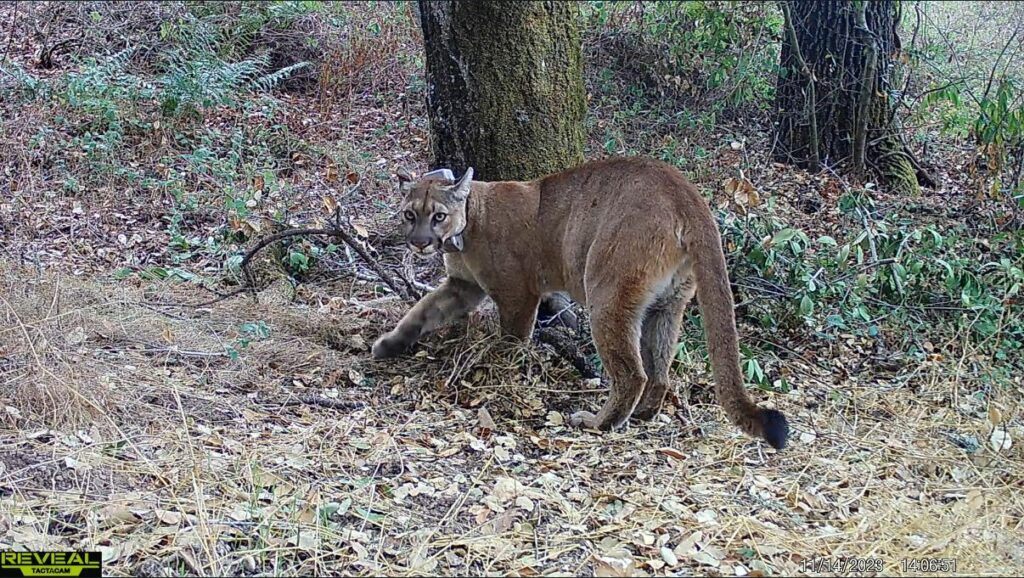
After a few months, her collar data began to fill in an area defining her home range. It was smaller than the average size for a female mountain lion in California, potentially indicating good resources and a high density of lions in the surrounding areas.
She began routinely returning to a single location, indicating that she was denning, and several weeks later, we detected her and her three kittens on our field cameras.
We also routinely detected a young female overlapping within F337’s territory, likely her offspring from the previous year, and the individual who had shared her bait on the eve prior to F337’s capture. Multiple males of different ages were also periodically detected, raising concerns regarding the safety of F337’s current litter. Still, the kittens regularly appeared on our cameras, almost always with very full bellies.
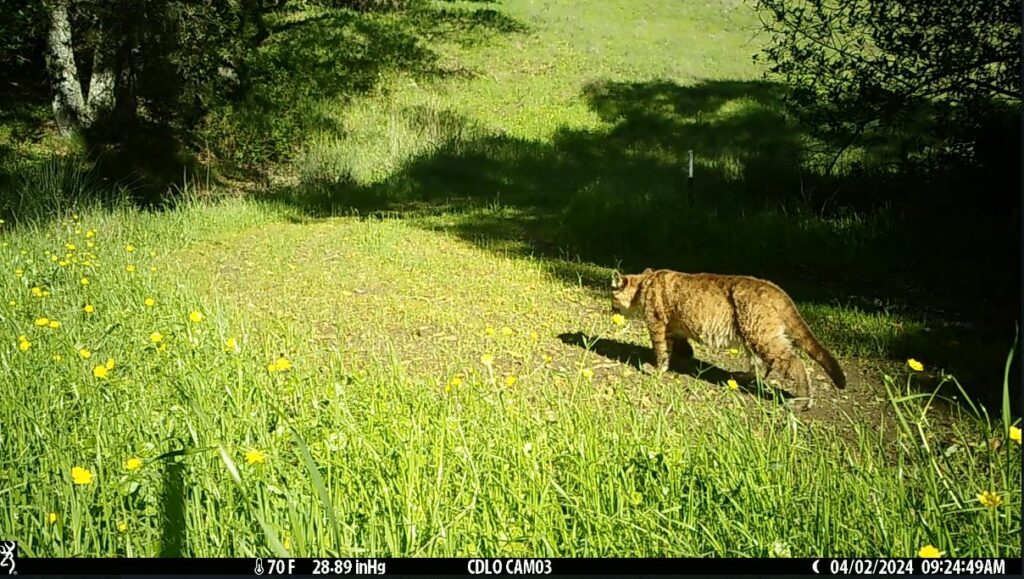
As the months rolled on, we watched the kittens lose their spots and grow as tall as or taller than their mother. I continued to set baits in the area to target other lions, placing them more than a mile from F337’s location. More often than not, she and her kittens found my baits, and I got to observe their feeding behavior.
F337 always found the bait first and fed briefly before retrieving her kittens. The two male kittens ate and got their fill before their little sister could partake. Mom sometimes intervened, standing over one of the males to allow the young female to eat without interference.
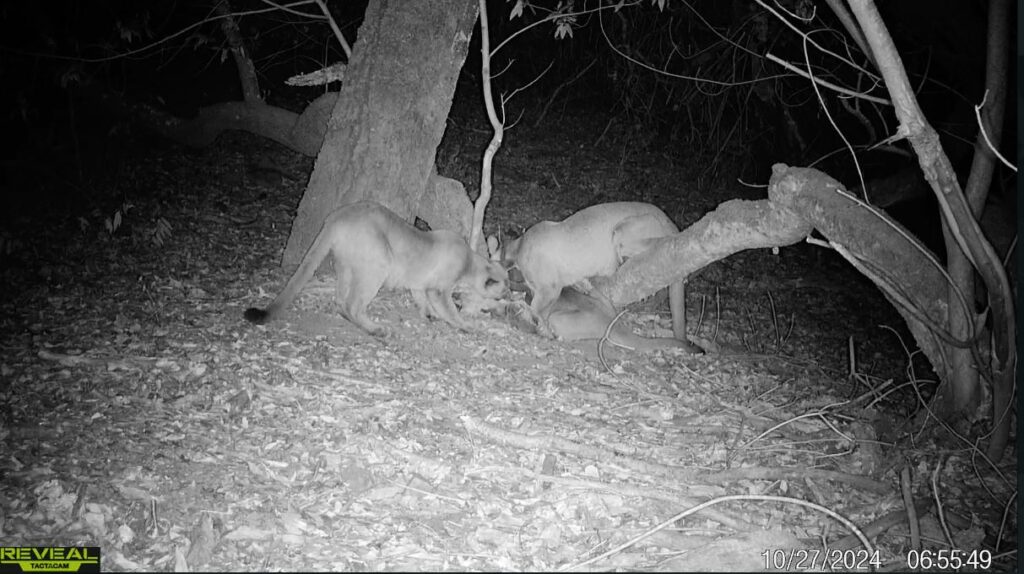
As the kittens neared dispersal age, we planned to capture and collar one or more before they set off independently.
While F337’s collar data showed us where her territory butted up against Hwy-152, she made no effort to cross. A dispersing lion, however, would likely approach and attempt to cross the highway, perhaps multiple times. Their collar data would be invaluable in finding out how they navigate the landscape and the treacherous Pacheco Pass Highway.
Would they locate the existing bridges or culverts? Would they cross at grade? If initially successful, would they continue to risk additional crossings, or would they carry on in search of an unoccupied area to carve out their own territory? Where would a wildlife overpass best support these movements?
F337 Killed on The Pacheco Pass Highway – November 2024
Unfortunately, we did not get the opportunity to collar any of the kittens. While out of town, I was notified that Caltrans had collected a dead lion from the edge of Hwy 152, near Bell Station. My heart sank when the notification read, “The lion has a collar and an ear tag with the number 337 on it.” The kittens were nowhere to be found.
In my absence, Matthew Fogarty, the Senior Land Management and Monitoring Specialist for the Santa Clara Valley Habitat Agency, collected F337 from Caltrans, removed her collar, and placed her in one of the Habitat Agency’s Freezers. Matthew had also assisted with F337’s capture and workup. She was his first.
Shortly upon returning home, I transported F337’s carcass, along with the carcass of a young unmarked male lion that had been killed along Hwy 101, to the UC Davis Wildlife Health Center Laboratory. The young male lion was killed near the proposed Highway 101 Wildlife Overpass Project site, which Caltrans and the Land Trust of Santa Cruz are currently planning.
I also immediately began setting baits where F337 and her kittens had previously fed, but we have not detected any of them on our cameras. Some research suggests that they may have been old enough to fend for themselves, but we may never know for sure. This is a painful reminder that the death of a single mountain lion female can often mean the death of the entire family.
After avoiding the highway for so long, why would F337 suddenly attempt to cross? Was she helping her kittens begin their dispersal? Did a new male enter the area, threatening the kittens’ safety?
Although we cannot answer these questions, we remain hopeful that improving the current infrastructure of bridges and culverts and constructing a wildlife overpass will prevent this outcome for other mountain lions along the Pacheco Pass.
If you’d like to learn more about California Mountain Lions, you can check out the stunning eight-part miniseries created by the California Mountain Lion Project. I’ve provided a link on the home page.
Tribute to Mountain Lion F337 – Video
Thank you for visiting WildlifeDetections.com. Check back often for new content or subscribe to my newsletter to receive updates on new articles. If you have enjoyed this post, please don’t hesitate to share.

